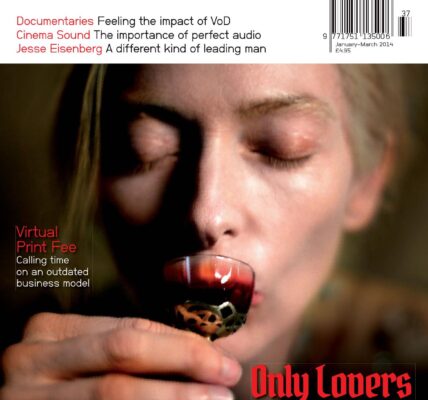Brave New World: Pt 1
However we characterise the current testing period for international film, it is not a crisis of demand. As the box office reminded us last year, people want film. But the distribution and exhibition ends of the business are having to deal with a difficult reality: that people want film on their own terms.
Digital technologies have created the potential for a more demand-driven business, but they challenge traditional business models. Distributors and exhibitors have united on dealing with the most glaring downside of digital change: piracy. But providing legitimate alternatives is a much more complex issue, and one that accentuates tensions between the two customer-facing sectors.
These issues are now coming to a head with the rapid advance of D-cinema and the development of more convincing download and streaming businesses. At the forefront in the UK are the Cinema Exhibitors’ Association and the Film Distributors’ Association, separated by a couple of floors in the same Soho building but both trying to map out a clear future…
Mark Batey CEO, Film Distributors’ Association
Among the first clichés of the digital era in cinema was that it would cut out the ‘middle men’, allowing producers to go straight to the consumer. Self-distribution, though, hasn’t yet made it much beyond the margins. There may be a restructuring of the industry to close the gap but Mark Batey, chief executive of the Film Distributors’ Association (FDA), believes the value of the distributor is becoming increasingly recognised—not least because so much digital innovation is coming from the sector. Rather than the bureaucratic middle, suggests Batey, “distribution is the lynchpin that links content and audience. It is absolutely key in this world of huge choice.”
It is an idea that will be thoroughly tested in years to come. The first trial of this digital endurance, however, is about survival in what is already proving a painful transition to digital cinema and online delivery. D-cinema has been a difficult process. Far from delivering the promised huge savings in costs, a long, drawn-out transition to D-cinema is actually proving a burden. Right now, distributors are having to run a ‘twin format’ approach of digital and 35mm prints, without the infrastructure of electronic delivery.
The cost-sharing mechanism to help fund the conversion— the virtual print fee (VPF)—ties distributors into the old costs without the control over use that is part and parcel of physical products. “The funding of conversion has been at the root of our problems,” says Batey. “The finance mechanism at the centre of D-cinema change has been the cause of considerable concern and a degree of friction with cinema owners.” Add in the decline of DVD sales and the still nascent online revenues and you have a difficult road ahead.
As with exhibitors, not all distributors will survive, or will necessarily want to continue in this new world. But the FDA represents a group of distributors that have been planning ahead and are focused on the bigger picture. While the VPF is at the centre of concerns right now, it is as a problem to be endured in the short term, rather than something to be fought. “There doesn’t seem to be any other model in town,” Batey concedes. But there is an end in sight. By 2012 or 2013, the UK will be 75 per cent digital and that “really will be a different world.”
It will be a world in which the economics of distribution and exhibition are changed, and one where the traditional rules of engagement between the two are challenged. Exhibitors will want control over content to meet local customer demand, and distributors will want to maximise screen time and open up new platforms and markets. Or put more simply, optimism for the exhibition business is based on more control of new kinds of content, while the distributors is on exploiting new platforms.
“There are two distinct business models with exhibitors having access to other forms of revenue that just don’t apply to distributors,” says Batey, although he believes mutual interests will ultimately outweigh conflict. “The ask is for a degree of flexibility, it is not to try to impose a one size- fits-all model on everything from Avatar to Antichrist. But the overall goal in all this is absolutely shared by all and there is a path mapped out. We are partners in the trade, absolutely in it together.”
D-cinema is, however, only one part of the equation. Distributors are also looking at how a declining physical product in DVD can be supplemented by new forms of online delivery. To an extent, this is an area where new technological developments will be a key factor—not least the missing link that will remove the gap between Internet and television. “People at home are already moving to the idea of a server, a kind of entertainment jukebox that might be Google-branded, Sky-branded, BT-branded, even Tesco, LoveFilm, where you can download anything to your plasma TV in great quality,” says Batey. The change should be supported in the UK by YouView, an initiative which aims to create a platform which seamlessly ties in the Internet and TV. “We are just touching the digital communication opportunity.”
An opportunity, though, that has proved tough to turn into business in other industries, notably music.
“It is a more fragmented model, a more complex model with a lot more challenges and an intently congested world of opportunities.” Batey, however, sees that congestion may actually prove the basis for the future of distribution and indeed exhibition. In a world of dizzying choice, the key may be to become the trusted gatekeeper.
“YouTube has millions of videos and it’s not good enough to say we are going to bung it online and people will download it. You might have 50 million viewings of Susan Boyle because that is driven by
the biggest television franchise in the world, but most get 20 or 30 viewings. Distribution may have the image of warehouses and lorries but it is really about understanding how to connect the best content with audiences.”
And Batey believes that role may be fundamental to the broader health of the film industry.
“Where is the next generation of talent going to come from if you haven’t got distribution in the middle? It is not going to happen by osmosis.” www.launchingfilms.com











